-
-
- Kitchen accessories
- Breathalyzers
- Blenders, mixers and planetary robots
- Electric kettles
- Coffee machines and coffee
- Waffle makers
- Frytownice (Air Fryer)
- Ice makers
- Microwaves
- Ovens and stoves
- Pressure cookers
- Soda makers
- Toasters, sandwich makers, electric grills
- Thermoses and thermal mugs
- Kitchen scales
- Irons and steamers
- Heaters
- Air treatment
- Fans and air conditioners
- Vacuum cleaners
-
- Locators
- Warranties and digital licenses
- Consoles and accessories
- Gsm accessories
- Cctv monitoring
- Tablets and e-book readers
- Photography
-
Network equipment
- Voip
- LTE, 5G
- Cables and patch cords
- Rack cabinet accessories
- Olt and ont
- Network accessories
- Wi-Fi / LTE antennas
- Enclosures, splices, boxes
- Rack cabinets
- Fiber optic welders and tools
- Access points
- Switches
- Uchwyty i akcesoria montażowe
- Sfp modules
- Power supply
- Wi-Fi signal boosters
- Routers
- Radio lines
- Powerline
- Cable pulling pilots
- Media converters
- Computers and gaming
- Drones and accessories
- Power supply
- Smart glasses
- Liczarki do pieniędzy
-
- Nasal aspirators
- Inhalers
- Lamps, star projectors
- Pregnancy pillows
- Bottle warmers
- Bottle sterilizers
- Children's thermometers
- Potty chairs and seats
- Lactation massagers
- Children's room
- Toys, games and education
- Bottles, bidons and accessories
- Breast pumps and accessories
- Bathtubs and bathing accessories
- Strollers for children
- Clothing
What is band aggregation and how it works using Teltonika RUT 260 as an example
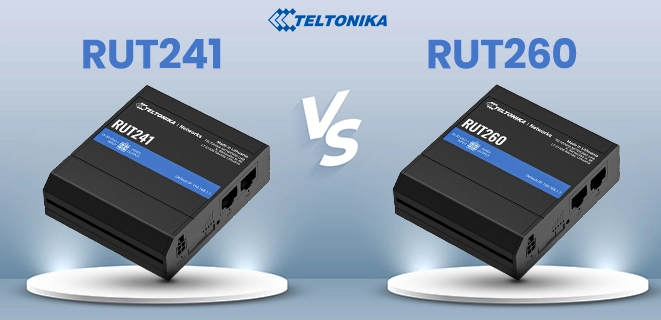
Band Aggregation(Carrier Aggregation) is a technology that is not so new anymore. Many modern phones have long supported frequency aggregation, but what is it and what is it used for? Let's get into a bit of theory:
Mobile communications, and LTE technology in particular, support different frequency ranges - so-called bands (bangs). In each of these bands, despite the name of the technology (e.g. LTE1800), not one specific frequency operates, but several channels ranging from several megahertz wide. This allows devices to operate independently of each other without causing interference.
The number of channels, as in any technology using radio waves, is strictly limited. What's more, channels or range can be assigned to a specific mobile operator or base station. LTE modems or LTE routers (4G routers) are based on these principles.
Mobile communications, and LTE technology in particular, support different frequency ranges - so-called bands (bangs). In each of these bands, despite the name of the technology (e.g. LTE1800), not one specific frequency operates, but several channels ranging from several megahertz wide. This allows devices to operate independently of each other without causing interference.
The number of channels, as in any technology using radio waves, is strictly limited. What's more, channels or range can be assigned to a specific mobile operator or base station. LTE modems or LTE routers (4G routers) are based on these principles.

Logically, the smaller the channel width (1.5, 3, 5, 10, 15 or 20 MHz), the more subscribers the base station can serve, but then the data transmission speed suffers. This is always noticeable during events with a large number of people in a confined space. Speeds usually drop many times over.
The frequency aggregation function in LTE modems or LTE routers allows several channels to be combined (aggregated), even in different LTE technologies. For example, in the LTE1800 band, you can combine several channels with a width of 20 MHz and get a multiband channel with a width of 40 MHz. Or an example of aggregation in different bands, for example, taking three channels of 20 MHz width in the LTE800, LTE1800 and LTE2600 bands will yield a multiband channel of 60 MHz width. In this way, aggregation helps increase speeds by as much as 2-3 times, even with loaded base stations and a large number of subscribers.
The frequency aggregation function in LTE modems or LTE routers allows several channels to be combined (aggregated), even in different LTE technologies. For example, in the LTE1800 band, you can combine several channels with a width of 20 MHz and get a multiband channel with a width of 40 MHz. Or an example of aggregation in different bands, for example, taking three channels of 20 MHz width in the LTE800, LTE1800 and LTE2600 bands will yield a multiband channel of 60 MHz width. In this way, aggregation helps increase speeds by as much as 2-3 times, even with loaded base stations and a large number of subscribers.

Teltonika RUT241 vs RUT260
Teltonika has long made a name for itself with its reliable, compact yet simple industrial routers. One such simple and affordable device is the Teltonika LTE router RUT241 i RUT260, which differ only in their built-in modem.
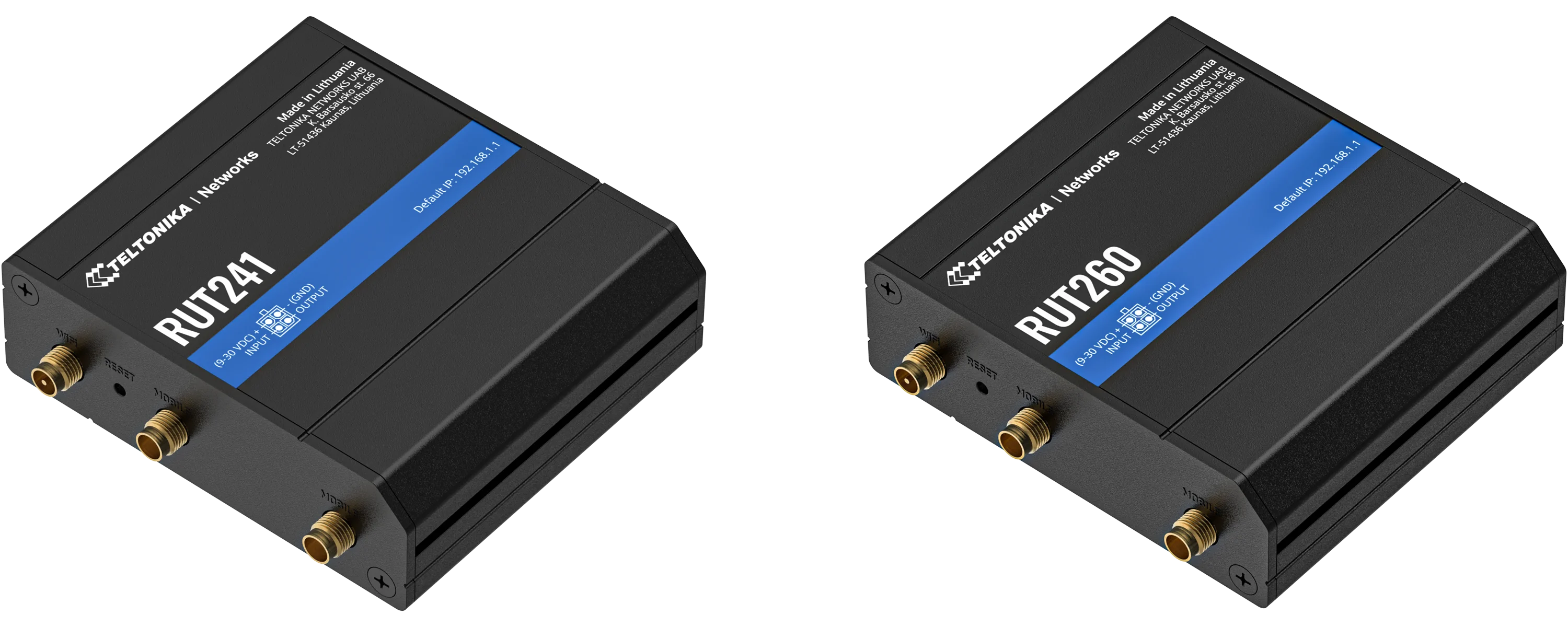
The RUT241 has an LTE Cat 4 modem, which means it can download data at a maximum speed (under ideal conditions) of up to 150 Mbps and send data at up to 50 Mbps. Generally, such speeds are sufficient for simple tasks and small amounts of data, but sometimes this may not be enough.
It is for this reason that the RUT260 was created, which has a built-in LTE Cat 6 modem, which in turn allows for download speeds of up to 300 Mbps and upload speeds of up to 50 Mbps. Such speeds can be achieved thanks to frequency aggregation (which we wrote about earlier).
Other than that, the devices are no different: they have the same chassis, the same number of connectors, features and 2.4 GHz Wi-Fi (b/g/n).
All that remains is to test and see if it's worth paying extra for LTE Cat 6, or is it just a marketing gimmick after all?
It is for this reason that the RUT260 was created, which has a built-in LTE Cat 6 modem, which in turn allows for download speeds of up to 300 Mbps and upload speeds of up to 50 Mbps. Such speeds can be achieved thanks to frequency aggregation (which we wrote about earlier).
Other than that, the devices are no different: they have the same chassis, the same number of connectors, features and 2.4 GHz Wi-Fi (b/g/n).
All that remains is to test and see if it's worth paying extra for LTE Cat 6, or is it just a marketing gimmick after all?
RUT241 vs RUT260 tests
Data speed tests will be conducted under the same conditions: The routers will be in the same place, the antennas will be set up equally, and the SIM cards will come from two operators(Orange and Play). So the tests should be as realistic and close to reality as possible.
First, we will connect RUT241 with the Orange operator and manually select the strongest channels at the location (that's LTE B1 and LTE B7) and conduct speed tests. We'll do the same with the RUT260, manually selecting one channel to make sure the routers achieve similar results.
First, we will connect RUT241 with the Orange operator and manually select the strongest channels at the location (that's LTE B1 and LTE B7) and conduct speed tests. We'll do the same with the RUT260, manually selecting one channel to make sure the routers achieve similar results.
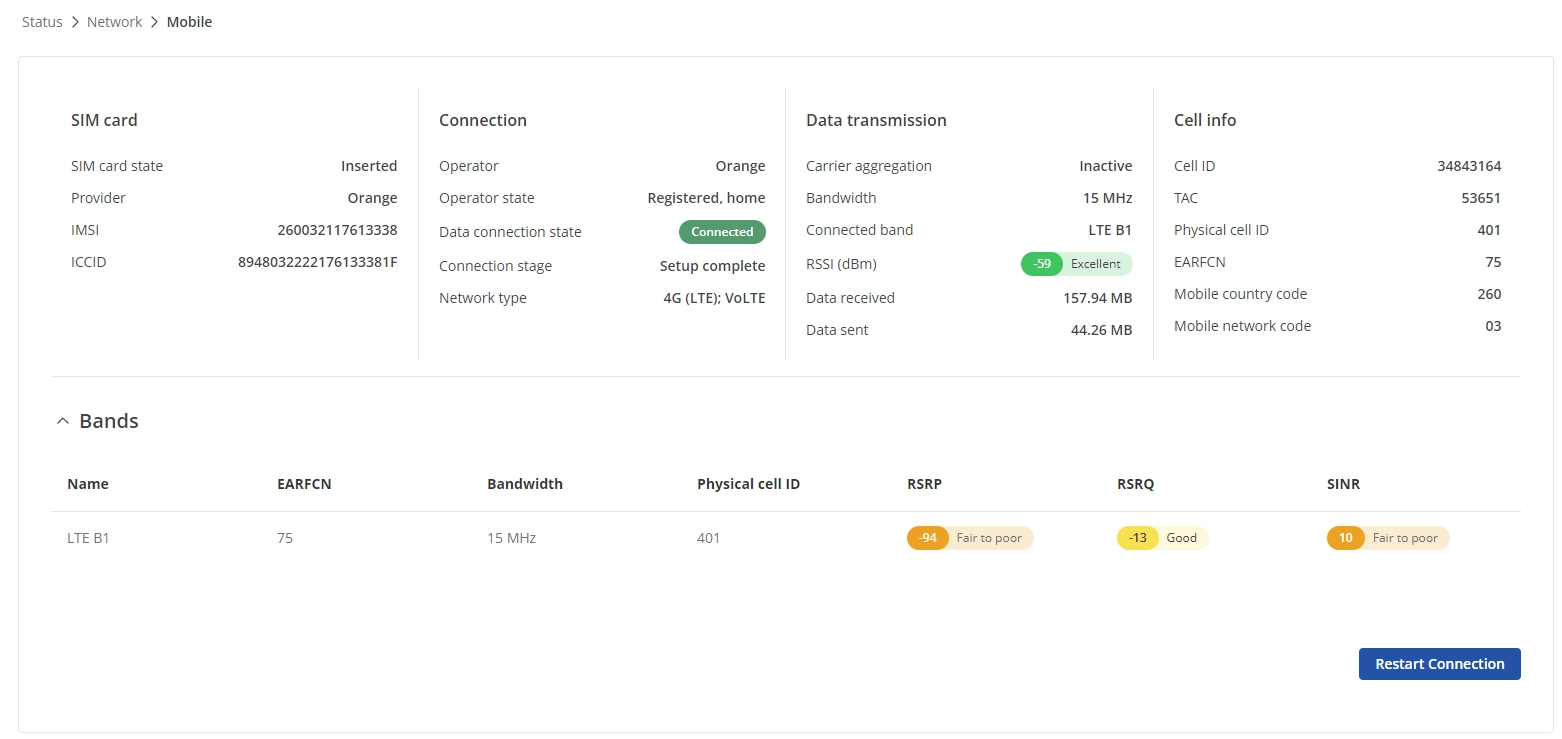

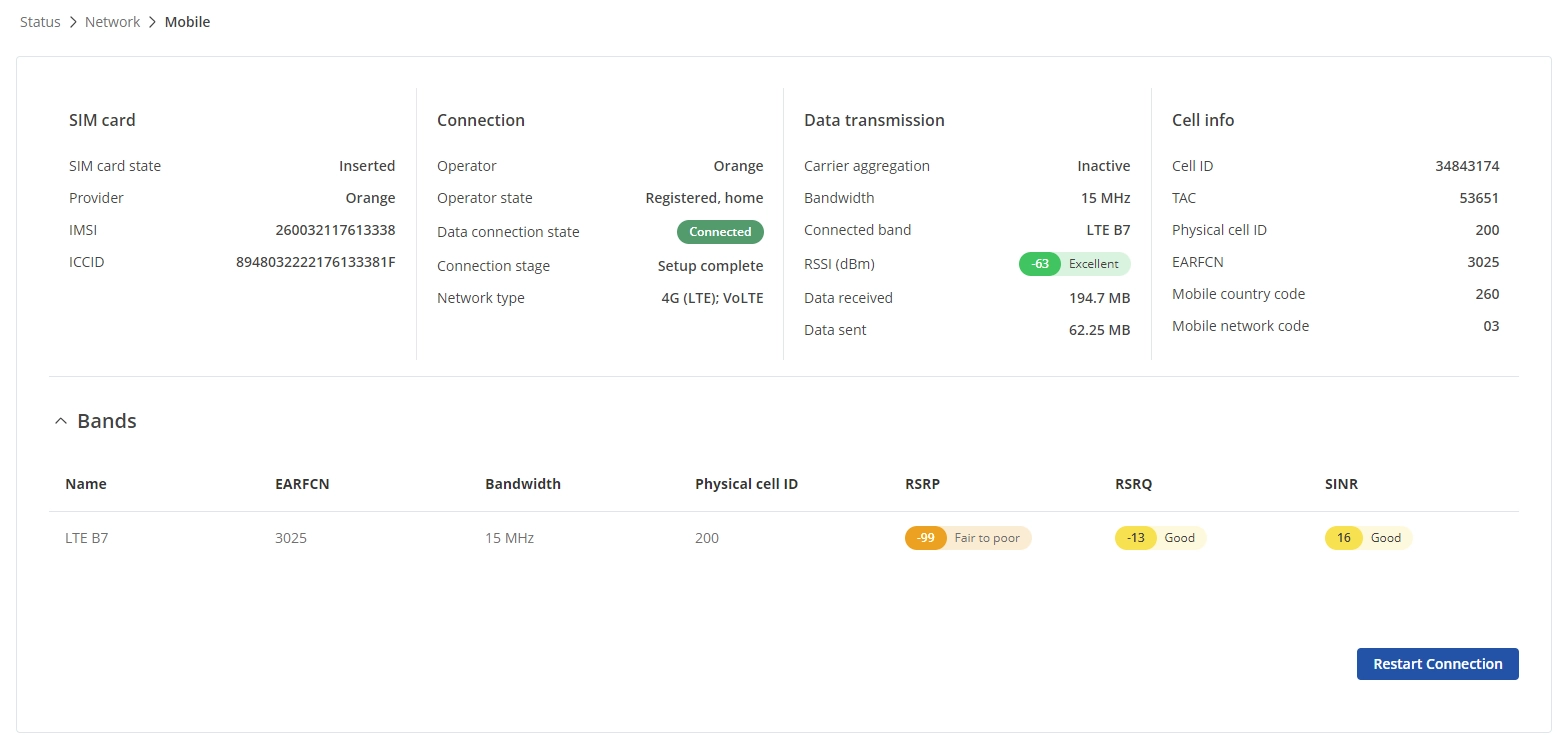

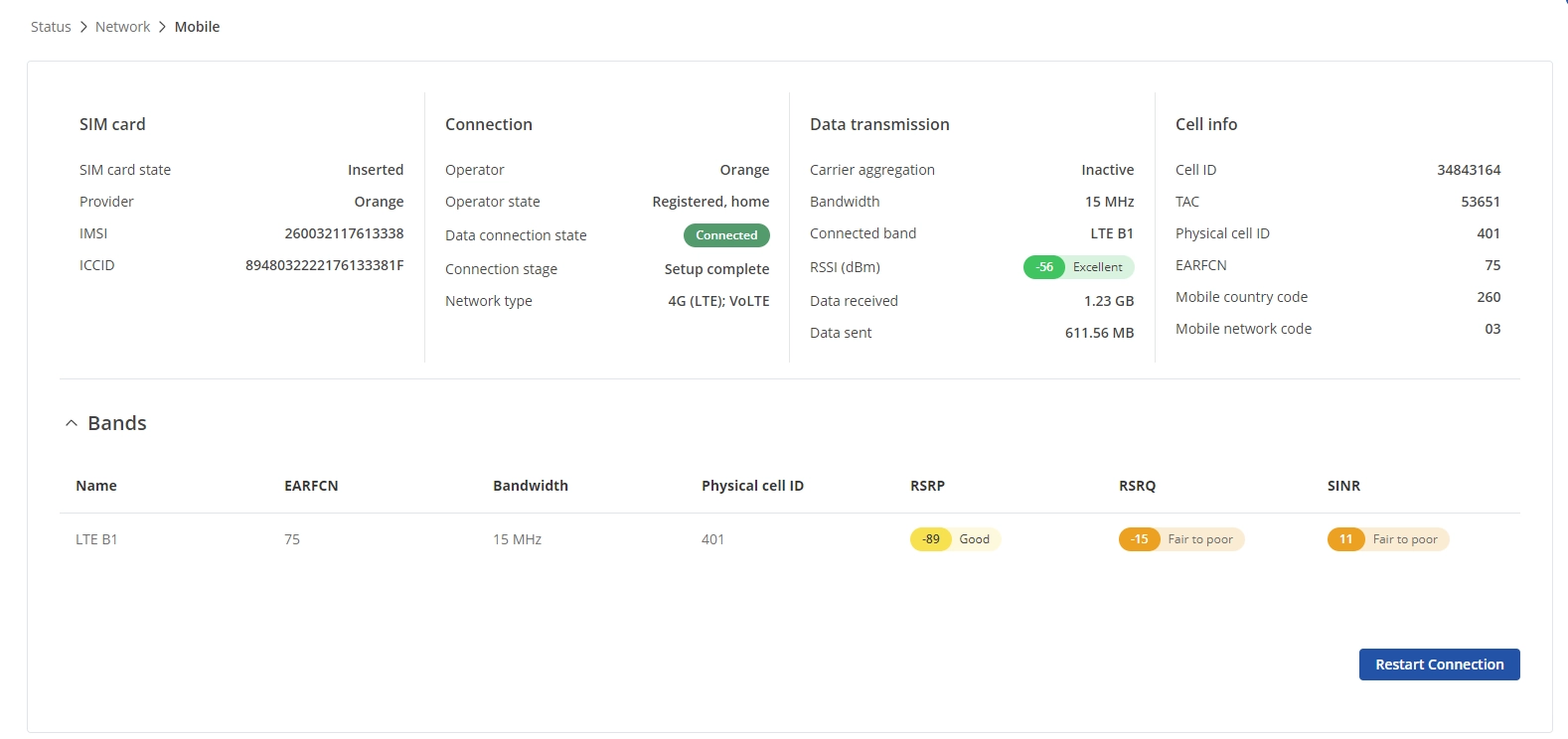


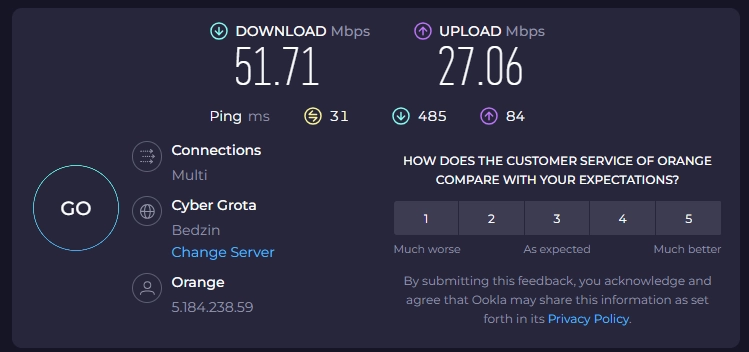
As a result, we have the following data:
| Orange | B1 (download / upload) | B7 (download / upload) |
|---|---|---|
| RUT241 | 14.06 / 8.29 | 28.47 / 23.41 |
| RUT260 | 28.27 / 20.74 | 51.71 / 27.06 |
And now let's see what speed the RUT260 can achieve with channel aggregation enabled:


As a result, the RUT260 aggregated the LTE B1 and LTE B7 bands in automatic mode, resulting in 71.18 Mbps for download and 28.82 Mbps for upload. This clearly shows that frequency aggregation does indeed increase data speeds.
We will run the same tests with operator Play and try to see if we get similar results, or if it was just a coincidence. The channels will be chosen the same (since they are strongest at this location) and we will see what results we get:
We will run the same tests with operator Play and try to see if we get similar results, or if it was just a coincidence. The channels will be chosen the same (since they are strongest at this location) and we will see what results we get:
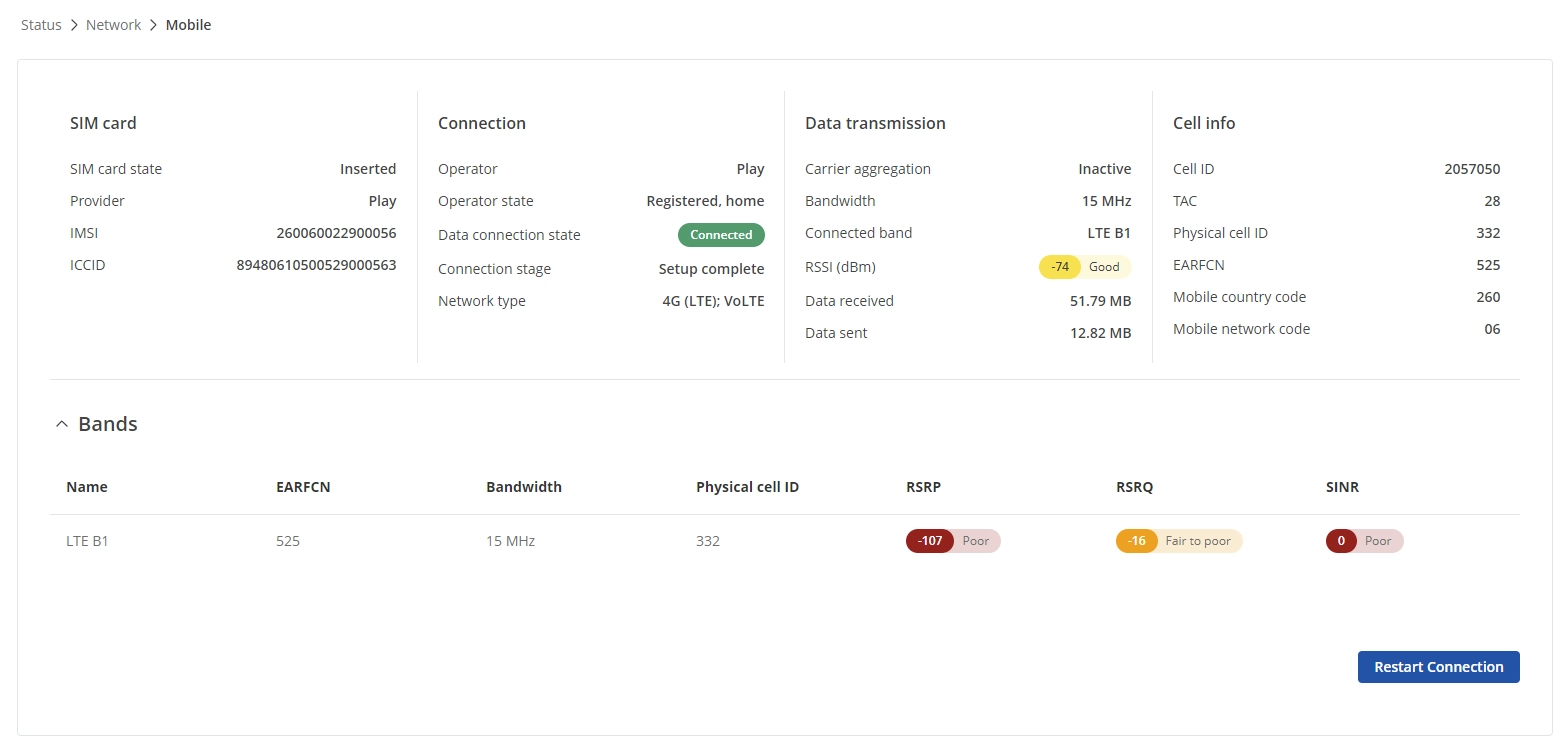
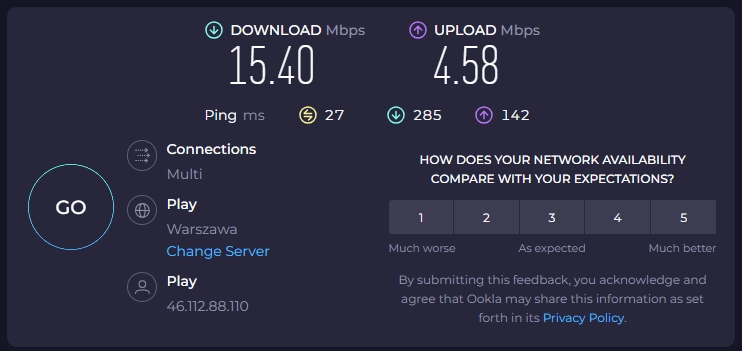
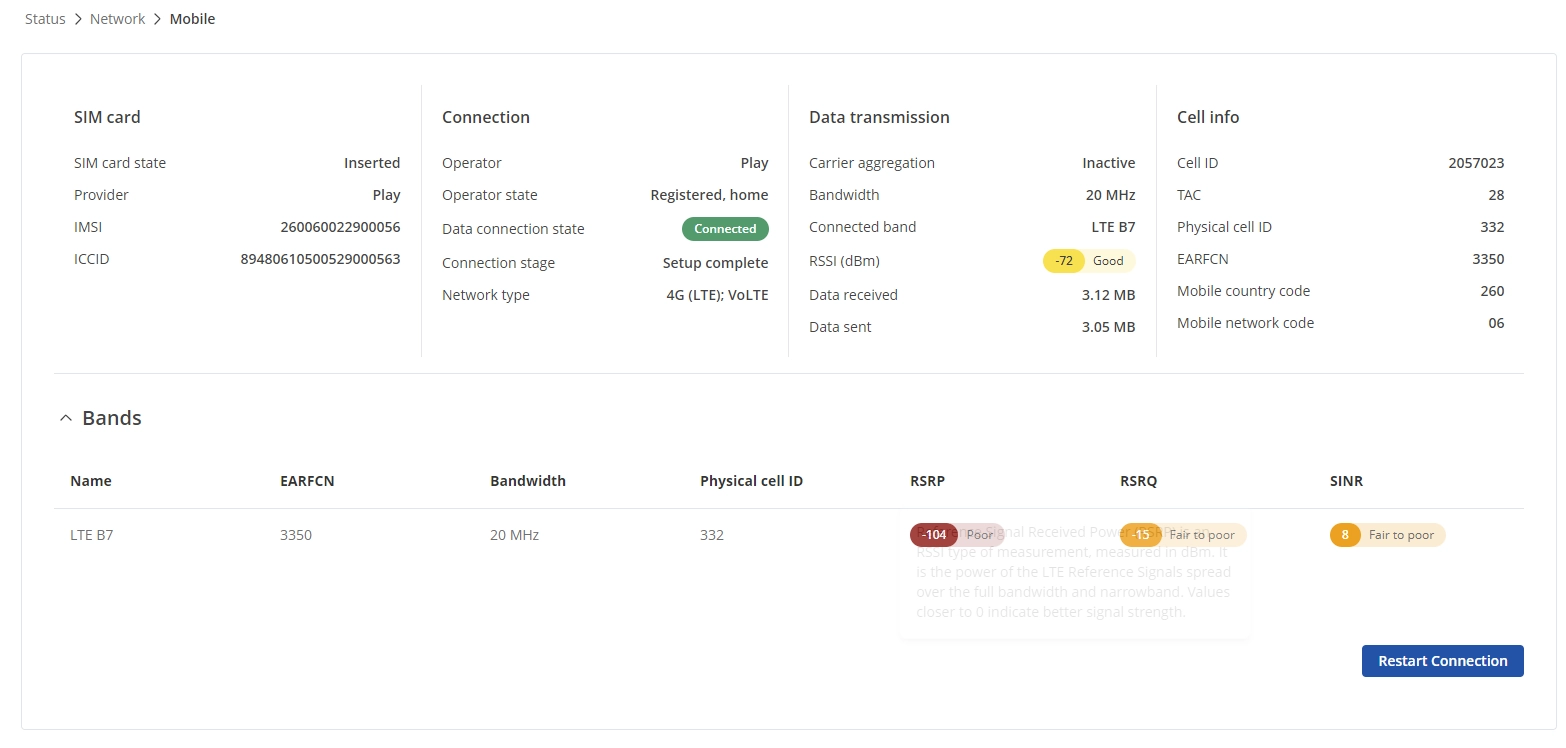
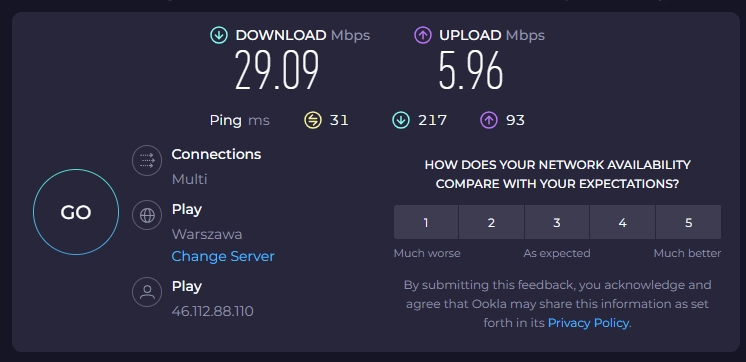


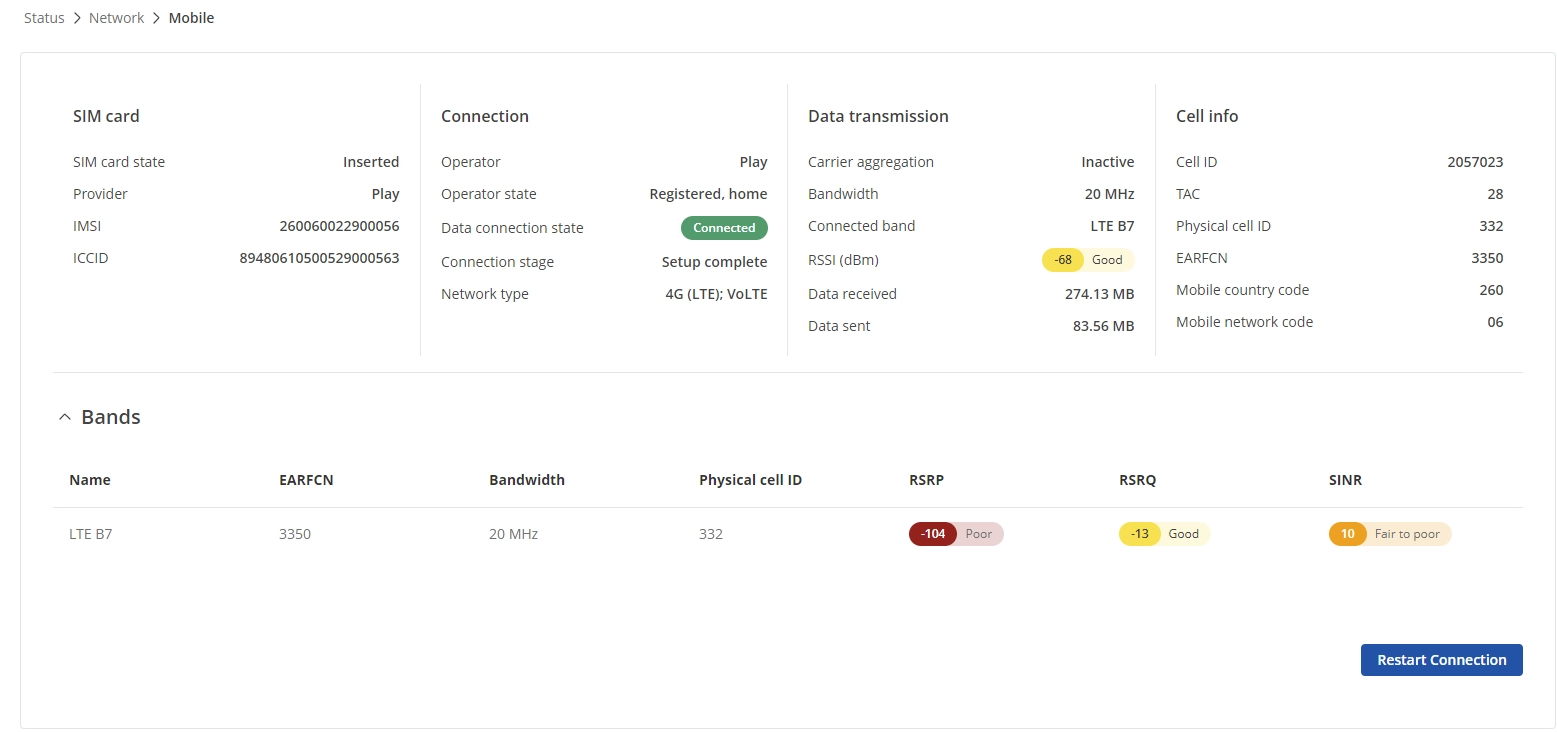
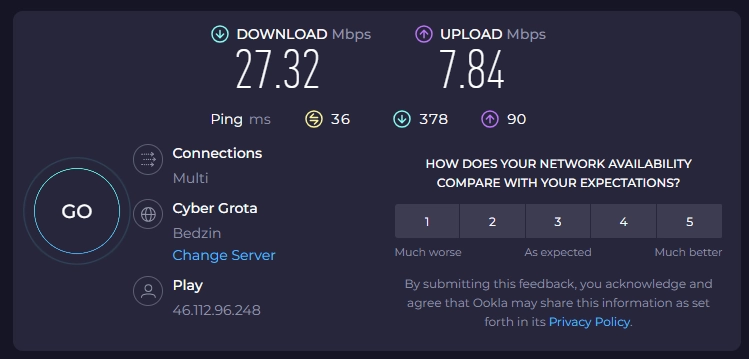
| PLAY | B1 (download / upload) | B7 (download / upload) |
|---|---|---|
| RUT241 | 15.40 / 4.58 | 29.09 / 5.96 |
| RUT260 | 17.84 / 8.73 | 27.32 / 7.84 |
And again we will see how RUT260 will cope with channel aggregation enabled:
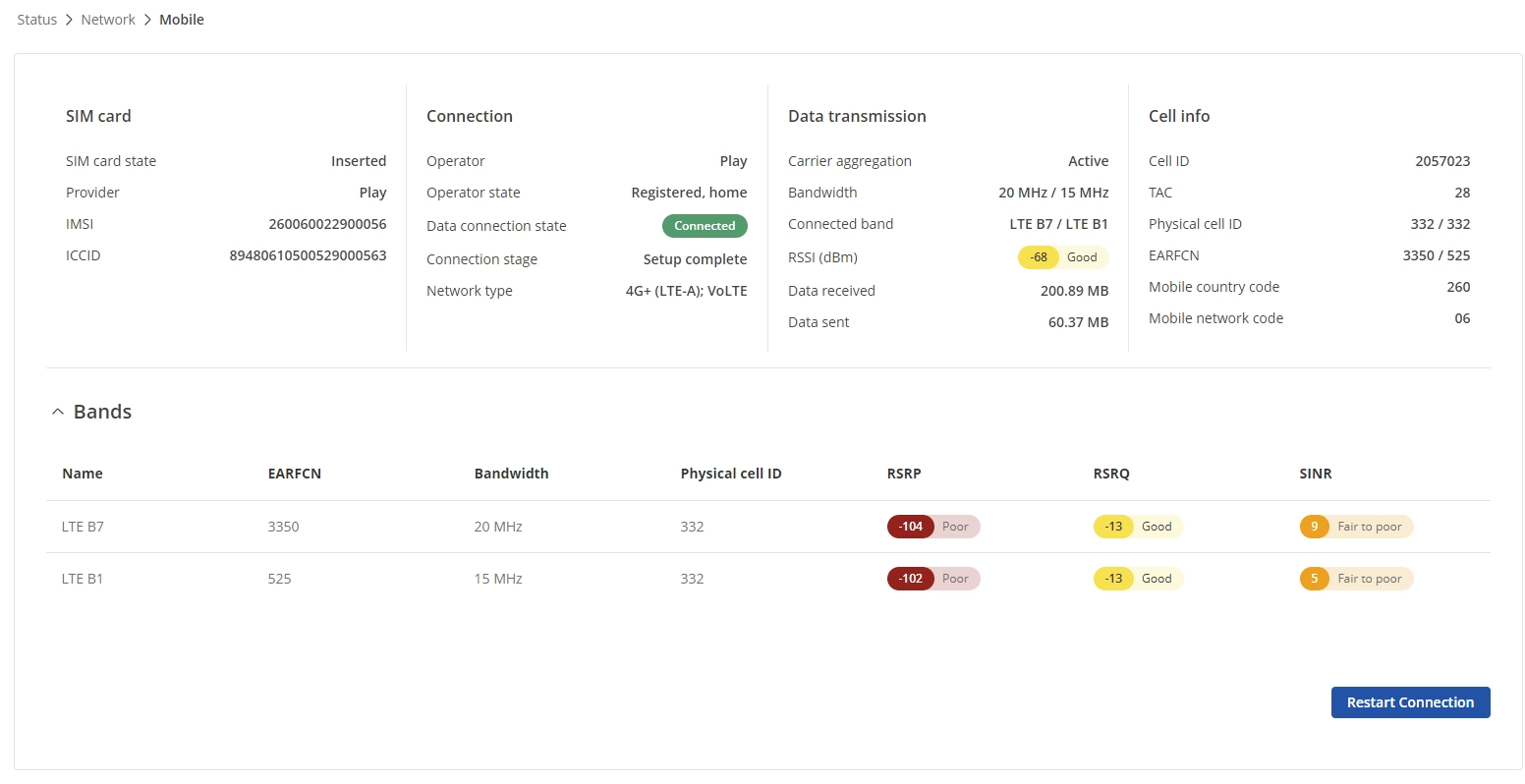

In Play 's operator, we see the following results: download speed is 44.10 Mbps, and upload is 7.62 Mbps.
Summary
As we can see, band aggregation does work, and speeds are indeed much higher than when using a single channel. Teltonika RUT260 really shows good results with active band aggregation. In our tests, we noticed an increase in speed by up to two times.
With our tests and the results we got, we can certainly say that band aggregation does a lot of work. All modern smartphones already use this technology, aggregating 2-3 or even 4 bands, which in turn significantly increases data speeds.
Author:
Aliaksandr Roslikau
With our tests and the results we got, we can certainly say that band aggregation does a lot of work. All modern smartphones already use this technology, aggregating 2-3 or even 4 bands, which in turn significantly increases data speeds.
Author:
Aliaksandr Roslikau
